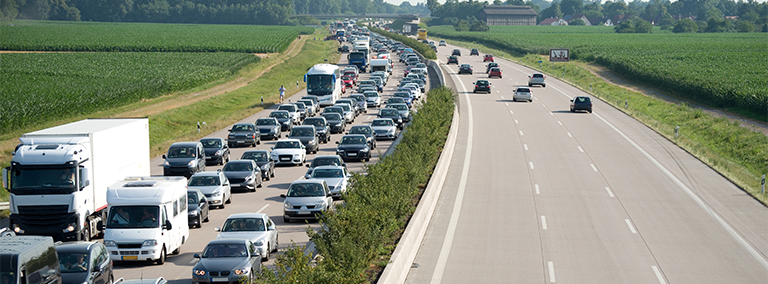Have you ever found yourself stuck in traffic for no apparent reason, with no accident, construction, or visible cause in sight? You may have experienced a phantom traffic jam. These seemingly random, frustrating slowdowns occur even when there’s nothing physically blocking the road.
Phantom traffic jams are a fascinating phenomenon caused by the way drivers behave in dense traffic, often triggered by small speed variations that ripple through the line of cars.
Understanding what causes these jams and how they can be prevented is key to improving traffic flow, reducing fuel consumption, and easing driver frustration. In this blog, we’ll dive into what phantom traffic jams are, how they form, and what steps we can take to avoid them.
What is a Phantom Traffic Jam?
A phantom traffic jam, also called a “ghost traffic jam,” is a traffic congestion event that happens without any apparent cause, such as road construction or accidents. These traffic jams form seemingly out of nowhere, triggered by small, human-induced disruptions.
For example, when one car slows down, it can cause a ripple effect where cars behind it also brake, leading to a chain reaction. As this wave of braking travels backwards through the line of cars, it creates a “snake” of stop-and-go traffic, despite no physical obstacles on the road.
Though phantom traffic jams may not significantly lengthen your journey, they do have some adverse effects:
– Increased fuel consumption
– Driver frustration
– Material wear and tear
– Higher risk of accidents
What is the difference between Phantom Traffic Jams and Traditional Traffic Jams?
While both phantom and traditional traffic jams can cause significant congestion, they differ in their underlying causes.
Traditional traffic jams are typically triggered by physical obstructions on the road, such as accidents or road closures. These events create a clear bottleneck that limits the flow of traffic.
In contrast, phantom traffic jams arise from the collective behaviour of drivers, forming spontaneously without any apparent physical cause. These “ghost jams” are often characterised by a wave of stop-and-go traffic that can propagate through a line of vehicles, even in the absence of any physical obstruction.
This unique nature of phantom traffic jams makes them a fascinating and challenging phenomenon to study and mitigate.

What Causes Phantom Traffic Jams?
Phantom traffic jams, also known as “jamitons” are a result of collective driver behaviour rather than any specific event. Here’s how a jamiton develops:
– Small Speed Variations: When one driver brakes or slows slightly, it forces the car behind them to react. This reaction often requires braking a bit harder, and the pattern amplifies as it moves down the line of cars.
– Reaction Time Delays: Drivers have natural delays in their reaction times. This means the car behind often overcompensates for the slowdown of the car ahead, which worsens the traffic wave.
– Shockwave Propagation: As each car slows down a bit more than the last, the ripple effect causes a shockwave of slow-moving traffic that travels backwards through the line of cars, even though there’s no external cause like an accident.
The primary factor that allows these “traffic snakes” to persist is the traffic density. If too many cars are packed closely together, these small disturbances can’t dissipate, creating a self-sustaining wave of stop-and-go movement.
Phantom Traffic Jam Equations
Several mathematical models are used to explain and predict phantom traffic jams. These equations generally demonstrate that as the density of cars on the road increases, their speed decreases until a tipping point is reached where cars can barely move.

Phantom Traffic Jam Research at MIT
Researchers at the Massachusetts Institute of Technology (MIT) have modelled traffic behaviour on circular roads to better understand phantom jams. Their findings show that these traffic jams can occur even if all drivers follow the same traffic rules. The problem isn’t necessarily bad driving; it’s the inherent nature of dense traffic flow.
Interestingly, MIT’s research reveals that drivers who drive “preventively ” can sometimes mitigate phantom traffic jams.” In lighter traffic conditions, drivers’ preventative behaviours, like maintaining larger distances between cars, reduce the risk of jams. However, in heavier traffic, the system becomes more prone to stop-and-go patterns, making phantom jams unavoidable.
By using mathematical traffic models, engineers can predict and even help design better roads and systems that minimise the occurrence of phantom jams.

How to Prevent Phantom Traffic Jams
While completely eliminating phantom traffic jams may be impossible, there are several strategies that drivers, road planners, and technology can use to reduce their occurrence.
Mindful Driving:
Avoid tailgating. Maintain a safe following distance, and adjust your speed based on what’s happening far ahead, rather than just the car immediately in front of you. Smooth, gradual braking can also prevent the need for sudden stops by others behind you.
Adaptive Cruise Control:
Many modern vehicles have adaptive cruise control, which automatically adjusts the car’s speed to maintain a safe distance from the car in front. This technology helps smooth out traffic flow and reduce the chances of phantom jams.
Smart Motorways:
Smart motorways use real-time traffic data to adjust speed limits. For instance, if traffic is slowing down ahead, cameras can detect it and lower the speed limit to prevent sudden braking further back in the line. This helps reduce the stop-and-go pattern that leads to phantom traffic jams.
Navigation Software:
Apps like Google Maps or Waze can help drivers avoid congested areas altogether. Some apps also provide recommended driving speeds to help smooth traffic flow and avoid unnecessary slowdowns.
Understanding phantom traffic jams can help us drive more mindfully, and emerging technologies like adaptive cruise control and smart motorways can assist in reducing their frequency. While we may never be able to completely avoid them, being aware of how they happen is the first step toward mitigating their impact.